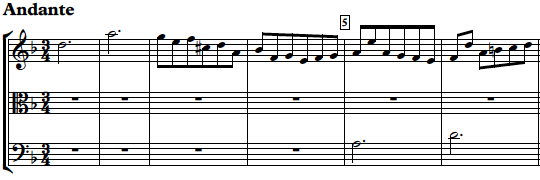composed by Scarlatti, Domenico
Scarlatti, Domenico (1685-1757) was an Italian composer. He wrote more than 500 keyboard sonatas, which are especially loved by keyboard players and piano music lovers. However, he is less well-known among string players because he composed few works for string instruments. Scarlatti’s music has a unique charm, and many of his sonatas, composed in two or three voices, can be played on string instruments. Therefore, I selected such works and arranged them for Violin and Viola duet or String Trio.
We used the following two sources as references when making the sheet music.
Domenico Scarlatti 90 Sonatas, edited by Nakamura, Yasuko, Ongakunotomosha, Tokyo (1982).
Domenico Scarlatti: Sonates, edited by Gilbert, Kenneth, Heugel, Paris (1984).
Sonata in D Minor, K.1 / L.413 for Violin and Viola
This is one of Scarlatti’s most well-known and beautiful pieces for keyboard. Originally composed as an exercise, it features large leaps.
- =86

Sonata in D Minor, K.9 / L.366 for Violin and Viola
This piece is in D minor, but it is light and beautiful.
- =72

Sonata in C Minor, K.11 / L.352 for Violin and Viola
It is simple yet beautiful and rustic.
- =86

Sonata in G Minor, K.30 / L.499 “Cat Fugue” for String Trio
This piece is said to have been inspired by a phrase improvised by Scarlatti’s pet cat on the harpsichord. Clementi named it “Cat Fuge.” It starts with a dispersed and mysterious theme, building into a refined three or four-voice ensemble.
- =102

Sonata in G Minor, K.35 / L.386 for Violin and Viola
This piece has a balanced and beautiful structure, with a dignified beauty.
- =76

Sonata in G Major, K.125 / L.487 for Violin and Viola
A lively and brisk piece, featuring rapid sixteenth notes and trills.
- =46

Sonata in A Major, K.208 / L.238 for Violin and Viola
The piece features a relaxed melody supported by quarter notes in the left hand. The second half of the melody becomes more complex, adding deeper nuance.
- =138

Sonata in F Major, K.367 / L.172 for Violin and Viola
This is a bright and cheerful piece with distinctive 16th-note contrary motion patterns.
- =138

Sonata in F Major, K.386 / L.171 for Violin and Viola
The left hand plays quarter notes, while the right hand plays eighth notes, creating a simple structure. However, the piece includes various nuances, with moments of dissonance and dramatic chromatic progressions, making it an outstanding composition.
- =72

Sonata in E Major, K.403 / L.470 for Violin and Viola
This piece is memorable because it often uses both whole steps and half steps that clash. These clashes make the simple chords that come afterward sound even more beautiful.
- =88

Sonata in D Minor, K.434 / L.343 for String Trio
This is a noble and beautiful piece with a melancholic melody progressing in counterpoint.
- =74

Sonata in D Major, K.435 / L.361 for Violin and Viola
A vigorous piece featuring rapid sixteenth-note runs, full of energy.
- =112

Sonata in G Major, K.455 / L.209 for Violin and Viola
A lively and bright piece, marked by a motif in eighth notes that moves in a narrow range.
- =64

Sonata in F Minor, K.466 / L.118 for Violin and Viola
The combination of eighth-note arpeggios in the left hand and melodic triplets in the right hand is beautiful. It sounds as if someone is trying to express a wish. In the second half, there are many interesting musical ideas. For example, the left-hand arpeggios change into rising scales.
- =102



